|
Voyages
of Awakening, 25 years of Höküle'a
By Sam Low
First Finalist, Society of Professional Journalists, Hawaii Chapter,
Feature Writing - Long Form, 2001; Kahili Award, Hawaii Visitors Bureau
award for best article celebrating Hawaiian culture, 2000.
Hana Hou Magazine
Photos
by Sam Low

In the quarter-century since she was first launched on March 8,
1975, the voyaging canoe Höküle'a, her dedicated crews and the multitude
of others who have contributed to her success have proved the incredible
prowess of the Polynesian seafaring heritage many times over. But even
more importantly, they have helped to revive an ancient culture and
reunite a diverse and widespread people. Over the last twenty-five years,
a vision has evolved among the canoe's vast family - one that finds
in the traditions of Polynesia universal lessons that may guide us all
in the new millennium. This is the story of that family and that vision.
From Captain Cook's Quandary, a Dream is Born
In 1778, when Captain James Cook discovered that the people of Hawai'i
were of the same race as those he had encountered throughout Polynesia,
he asked: "How shall we account for this Nation having spread itself
to so many detached islands?" How indeed could a stone-age people have
navigated and explored a third of the earth's surface without instruments
or charts? How could they have built powerful sailing vessels without
metal nails or canvas sails?
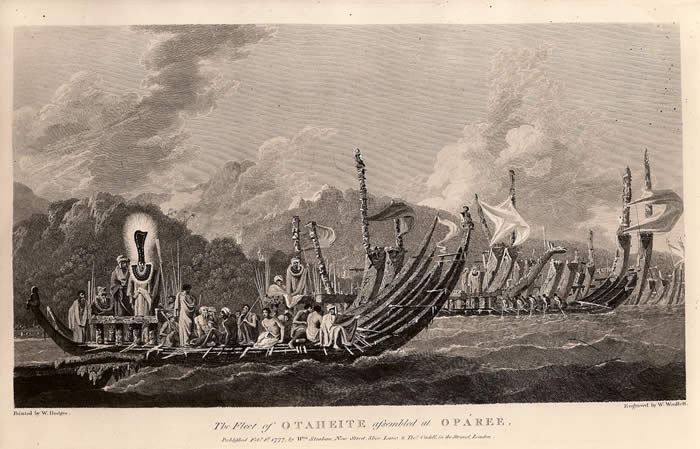
Polynesian war canoes at Tahiti sketched by Cook's artist
Some early scholars suggested that South American Indians could possibly
have settled the Polynesian islands simply by drifting westward on crude
rafts, riding the prevailing currents and winds. In 1947, Norwegian
explorer Thor Heyerdahl set out from Peru to test this theory aboard
his famous balsa-wood raft, Kon Tiki. Despite many dire predictions
that the simple raft would surely be smashed to pieces in the open ocean,
Heyerdahl and his crew eventually managed to make landfall in the Tuamotu
Islands, just east of Tahiti, indicating to some that at least part
of Polynesia could have been settled this way. But by the late 1960s,
mounting scientific evidence began to point toward a much different
source of origin for the ancient Polynesians. Increasingly, archaeological
and linguistic studies indicated that the true Polynesian homeland lay
to the west - in the area of Southeast Asia. This meant that to settle
the islands they must have sailed against the powerful prevailing tradewinds
and currents, which in turn suggested that they possessed highly efficient
oceangoing vessels and a vast cultural storehouse of navigational knowledge.
Some scholars at the time continued to maintain that any such settlement
must have occurred purely by chance, perhaps by fishing canoes that
had been accidentally blown to sea. But this hardly seemed to explain
the incredible dispersal of the Polynesian people over immense distances
of the Pacific. And furthermore, ancient Polynesian chants and myths
told clearly of powerful canoes and great navigators. Could the myths
be true? In the early 1970s, three men decided to find out.
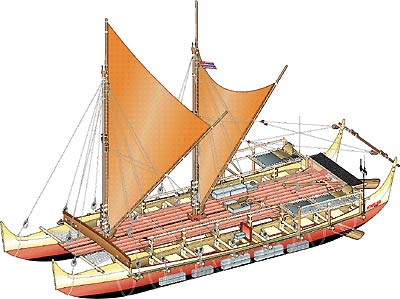 |
"Höküle'a
came from the dream of three people," recalls Polynesian Voyaging
Society director and head navigator Nainoa Thompson. "Dr. Ben Finney,
an anthropologist from Santa Barbara; Herb Kawainui Kane, an artist
of Hawaiian descent; and writer and community leader Tommy Holmes,
a man who truly loved the sea. They said, 'We want to test all these
theories about how Polynesia was settled, and the only way to do that
is to get out of the four walls of the academic world and build a
voyaging canoe and sail it to Tahiti.'"
Finney, Kane and Holmes founded the Polynesian Voyaging Society in
1973. "We made a great team," says Kane, "because we approached the
Höküle'a project from different points of view. Ben was the scientist,
Tommy was the waterman and adventurer, and I approached it from the
cultural point of view."
Although the PVS founders wanted to use traditional materials and
tools to construct the canoe, they realized that the process would
become too time-consuming as the builders tried to relearn the arts
of working with materials such as koa-wood hulls, woven lauhala sails
and sennit lashing. Instead, the hulls were constructed out of plywood
and fiberglass; the sails were made from canvas; and the lashings
were done with synthetic cordage. However, Höküle'a's creators strove
to approximate the shape and weight of a traditional canoe to create
a "performance-accurate" replica that handled as much like the ancient
Polynesian voyaging canoes as was considered possible.
The canoe was named Höküle'a, or "Star of Gladness," after the Hawaiian
name for the star Arcturus, which reaches its zenith directly over
Hawai'i and was likely to have been used as a prime navigational marker
by ancient wayfinders seeking to locate the Islands. Kane recalls
how the name first came to him: "One exceptionally clear night I stayed
up quite late, star chart in hand, memorizing stars and their relative
positions. When I finally went to sleep, I dreamed of stars, and my
attention was attracted to Arcturus. It appeared to grow larger and
brighter, so brilliant that I awoke. I turned on my reading light
and wrote 'Höküle'a.' The next morning, I saw the notation and immediately
recognized it as a fitting name for the canoe. As a zenith star for
Hawai'i, it would indeed be a star of gladness if it led to landfall.
The name was proposed at the next board meeting and adopted."
On March 8th, 1975, Höküle'a was launched. Its mission was to test
the theory that the ancient Polynesians were brilliant seafarers who
intentionally explored the Pacific, but how would the vessel be navigated
in the ancient way - without charts or instruments? Although the traditional
arts of navigating had been lost in Polynesia, a handful of seafarers
in the remote islands of Micronesia still found their way across trackless
ocean expanses using only the arc of stars, the wave patterns and
the flight of birds. One of them, Mau Piailug from the tiny island
of Satawal, agreed to guide Höküle'a to Tahiti.
Hokule'a off Diamond Head

On
May 1, 1976, Höküle'a left Hawai'i on her maiden voyage. Nainoa, who
flew to Tahiti to serve as a crew member on the return trip, remembers
the moment of arrival when Höküle'a reached Pape'ete thirty-three
days later: "I watched the canoe enter Pape'ete Harbor. Seventeen
thousand people came down - over half the population of the island.
The canoe got to the black-sand beach, and so many children got on
that it sank the stern. People couldn't see, so they climbed into
the trees. It was a spontaneous, innate reaction by a people who had
maintained their language and their genealogy, who understood who
their great navigators were. They knew about the great canoes, but
they did not have such a canoe. So when Höküle'a entered the bay she
was a powerful symbol that reminded them of the greatness of their
culture and their heritage - and therefore themselves. It was the
beginning, I think, of cultural revival and the renewal of the Polynesian
people."
Lost
at Sea: A Crisis and a Turning Point
In 1978 - with insufficient preparation and without Mau on board -
Höküle'a again left for Tahiti. But the voyage had hardly begun when
disaster struck: During rough weather in the middle of the night,
the canoe capsized between O'ahu and Lana'i. In a heroic effort, lifeguard
and big-wave surfer Eddie Aikau, one of Hawai'i's most experienced
watermen, tried to paddle to shore on a surfboard to get help. He
was never seen again.
Eddie's loss was a devastating blow. For many, he represented the
best of what it meant to be Hawaiian. "Eddie's death split the community,"
Nainoa remembers. "Some of us wanted to stop voyaging, but some of
us thought that if we did his death would have no value. I believed
that voyaging inspired our Hawaiian community and gave us all pride.
I believed we had to continue. It was Eddie's inspiration that kept
us together during those hard times."
Eventually, the PVS reorganized and recommitted itself to the renewal
of culture through voyaging, but only if it could be done safely.
The Society turned to Mau and asked him to share his sacred knowledge
of sailing and navigation, and for the next two years Mau helped prepare
a crew for another voyage to Tahiti. But this time, the canoe would
be guided by a Hawaiian - Nainoa.
"Mau trained us like his grandfather trained him," Nainoa recalls.
"He took us on the ocean like children, becoming our father and mother
at sea. We had very few formal lessons; the learning really came by
being close to him - looking at the things he looks at, feeling the
things he feels. Even though I'm now able to guide the canoe on my
own, I'm still his student. He is the only master navigator."
In 1980, Nainoa successfully guided Höküle'a to landfall in Tahiti.
By this time, the canoe had become a powerful symbol of Polynesian
renewal. Rediscovering the ancient arts of seafaring helped stimulate
a similar renaissance in language, dance, poetry, architecture, spirituality,
traditional medicine - all the core cultural values of a native island
people.
"The canoe brought back our traditions of the sea," says navigator
Bruce Blankenfeld. "There were people who knew about canoe making,
but they had gone underground after the Western influence came in.
But once we began to sail, we began to rediscover it all."
The Voyage of Rediscovery
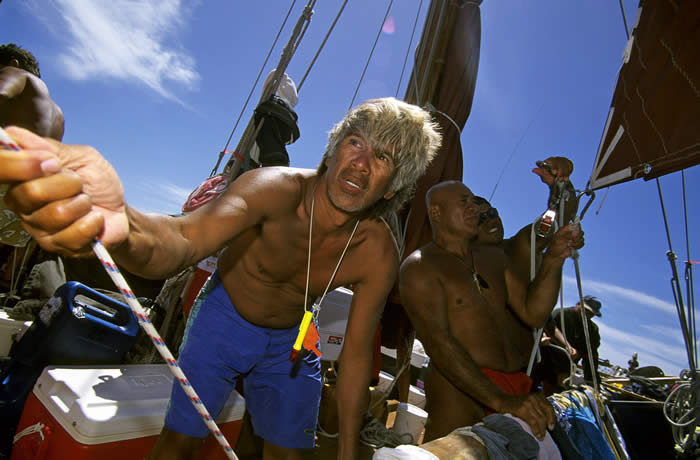
In 1985, Höküle'a embarked on a new mission. Her crew would traverse
most of Polynesia - a two-year, 16,000 mile odyssey - to carry the
message of cultural revival throughout the great Polynesian Triangle.
The canoe followed ancient migratory routes - from Hawai'i to the
Society Islands, the Cooks, New Zealand, Tonga, Samoa and back home
via Aitutaki, Tahiti and Rangiroa in the Tuamotu Archipelago. The
voyage eastward from Samoa to Tahiti retraced the first great migratory
steps believed to be have been taken by Polynesians at about the time
of Christ. It was also, once again, an opportunity to prove the mettle
of the Pacific's traditional seafarers.
"Thor Heyerdahl had said that it was impossible to get from western
Polynesia to Tahiti because of the easterly trade winds," says Nainoa.
"He thought that the old canoes could not tack against them. We set
out to prove him wrong. We trained for two years, we cut down our
crew and we cut down our rations of food and water. We made the canoe
light so that it would perform better, then we went to Samoa and waited
for the weather."
Heyerdahl and other scholars who thought it impossible for Polynesians
to sail against the winds and currents failed to consider that every
summer westerly winds blow with some regularity across the western
Pacific, and episodically extend into the eastern Pacific. Furthermore,
during El Niño events, the trade winds falter and more prolonged westerlies
blow across Polynesian waters. Höküle'a waited for one of these westerlies
and blazed across the distance from Samoa to Tahiti.
"We had planned for a thirty-five-day voyage, the longest ever," Nainoa
recalls. "And we did it in seven days."
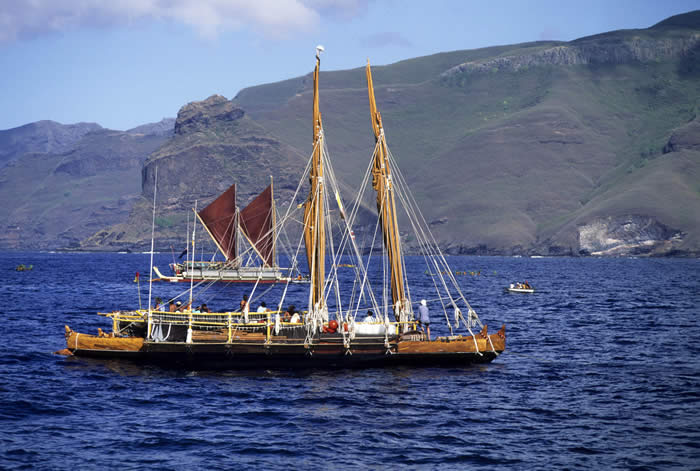
Hawai'iloa and Te Aurere - Marquesas
A
New Canoe - Hawai'iloa
Höküle'a had been built as a "performance replica" - shaped like an
ancient canoe but crafted from modern materials. Now that she had
proved her abilities beyond a doubt, the question became: How would
a canoe built from traditional materials perform? In 1990, the PVS,
in partnership with Bishop Museum's federally funded Native Hawaiian
Culture and Arts Program, decided to find out by building a new voyaging
canoe entirely of natural materials. She would be named Hawai'iloa
after the mythic fisherman who, according to chants and legends, was
the first discoverer of the Islands. The original intention was to
fashion Hawai'iloa 's hulls from koa, a Hawaiian native hardwood that
was believed to have been used in building the Islands' ancient voyaging
canoes. But PVS teams explored Hawai'i's forests for nine months without
finding a single tree that was big enough to use.
"The failure to find a koa log was a turning point for all of us,"
remembers Myron "Pinky" Thompson, Nainoa's father and president of
the PVS. "For a decade and a half we had focused our attention on
the sea. Now it was time to care for our land. We realized that our
culture and our planet cannot thrive unless our environment is healthy."
Since that moment, the PVS has focused a major effort on reforestation
and environmental education. Fortunately, there was another historical
source of wood for canoes: logs that drifted to Hawai'i from the Pacific
Northwest. In an extraordinary act of kindness, the native people
of southeast Alaska gave two 400-year old spruce logs to the Society
to build Hawai'iloa. The gift was arranged by a friend of Herb Kane's,
a Native Alaskan leader named Judson Brown.
"Judson taught us so much," Nainoa remembers. "The Alaskan people
care for their environment because they understand that the resources
of the natural world are sacred gifts. When he presented us with the
trees, he said, 'Our trees are part of our family, they are cherished
like our children. We will give you two of our children to build a
canoe that will carry your culture.'"
Building Hawai'iloa provided a way for an even larger Hawaiian community
to join in reviving the ancient traditions. Under the watchful eye
of master canoe builder Wright Bowman Jr., volunteer shipbuilders,
lashers, sailmakers, painters, caulkers and others labored more than
500,000 man-hours to breathe new life into the two giant spruce logs.
"Wright stepped forward to guide us and care for us with great aloha,"
says Bruce Blankenfeld. "Under his tutelage a new family of the canoe
was born." In 1993, after three years of arduous labor, Hawai'iloa
took to the sea. But even before she ever set sail, she had already
represented a new level of community involvement; she had played an
essential role in sharpening the Voyaging Society's appreciation for
the fragility of Hawai'i's environment; and she had cemented a deep
friendship between Hawaiians and the native peoples of southeast Alaska.
Canoes Across the Pacific
In 1992, stimulated partly by Höküle'a's epic voyages, the Sixth Pacific
Arts Festival in Rarotonga was dedicated to Polynesia's great voyaging
heritage. An invitation went out to islanders throughout the Pacific
to sail to the festival aboard replicas of their own ancestral canoes.
"That challenged everybody," Nainoa remembers, "so different island
groups each decided to build their own canoes. When they called Hawai'i
to ask for assistance, it was a great opportunity for us to pay back,
in a small way, the kindness that had been shown to us all through
the South Pacific. It also gave us the opportunity to move into a
new area - education."
Höküle'a sailed to Rarotonga for the festival, where she was joined
by sixteen other canoes from islands spread throughout the Pacific.
Now fully committed to a mission of education, the PVS created a unique
program called "The Voyage for Education" to accompany Höküle'a's
return from Rarotonga. Daily live reports broadcast on KCCN Hawaiian
Radio gave information about the canoe's position, weather conditions,
sailing strategy, navigational techniques and life on board. There
were also interactive links with a state-wide educational television
program and with students at the University of Hawai'i at Mänoa. Two
days after leaving Rarotonga, Höküle'a established a historic, three-way
satellite link with the space shuttle Columbia, which was orbiting
the earth, and a panel of schoolchildren in a TV studio at the University
of Hawai'i. The students posed questions alternately to the crew of
the canoe and the shuttle. One student asked, "What are the similarities
and differences between canoe and space travel?" Astronaut Charles
Lacy Veach, who grew up in Honolulu, answered: "Both are voyages of
exploration. Höküle'a is in the past, Columbia is in the future."
Nainoa added from the canoe: "We feel both are trying to make a contribution
to mankind. Theirs is in science and technology. Ours is in culture
and history. Columbia is the highest achievement of modern technology
today, just as the voyaging canoe was the highest achievement of technology
in its day."

Cook Island canoe off Honolulu
Nä 'Ohana Holo Moana - "The Voyaging Family of the Vast Ocean"
The pace of Polynesian cultural revitalization continued as new voyaging
canoes were built - the Makali'i in Hawai'i, two in Tahiti, two in
the Cook Islands and one in Aotearoa (New Zealand). In 1995, all three
of the Hawaiian canoes met with others from around Polynesia at the
island of Ra'iatea, near Tahiti, for a ceremony to reopen an ancient
marae (temple) of navigation called Taputapuatea. This was particularly
significant since the temple, which lies at the symbolic center of
the Polynesian Triangle, was historically a great gathering place
for the canoes and navigators of many islands. More than 600 years
before, however, a powerful kapu (religious taboo) had been placed
on the marae after a Maori chief was killed there. The profoundly
emotional ceremony at the marae removed that kapu and brought about
a blessing once again for a united voyaging community of all Polynesians.
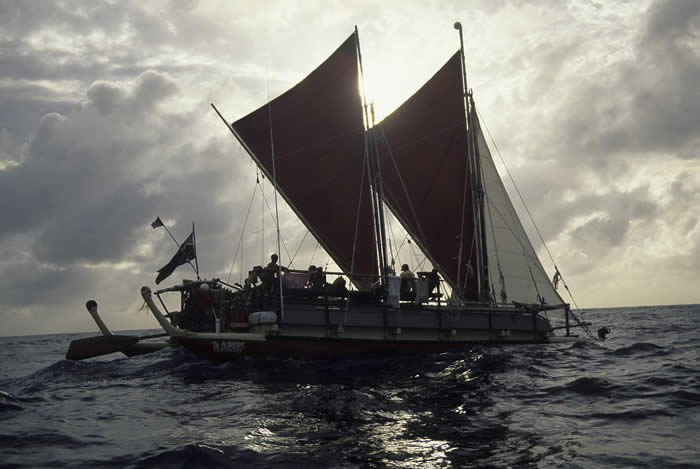 Soon after the ceremony, six canoes - Höküle'a, Hawai'iloa and Makali'i
from Hawai'i; Te Au o Tonga and Takitumu from Rarotonga; and Te Aurere
from Aotearoa - left the Marquesas Islands for Hawai'i, following
a traditional voyaging route. It was the first time in hundreds of
years that a fleet of Polynesian sailing canoes had journeyed together
- a new 'ohana (family) of the ocean star paths. Almost immediately
after arriving home in Hawai'i, Höküle'a and Hawai'iloa were shipped
to Seattle for a "Voyage of Thanksgiving" along the Pacific coast
of the North American continent. Höküle'a sailed south along the West
Coast, reaching thousands of Hawaiians who no longer lived in the
Islands, but longed to share in the canoe's legacy. Hawai'iloa sailed
north to thank the native peoples of Southeast Alaska for their gift
of trees for her hulls. This was an opportunity for the PVS to give
back to them, but at each stop the canoe and crew were overwhelmed
with gifts and kindness. Soon after the ceremony, six canoes - Höküle'a, Hawai'iloa and Makali'i
from Hawai'i; Te Au o Tonga and Takitumu from Rarotonga; and Te Aurere
from Aotearoa - left the Marquesas Islands for Hawai'i, following
a traditional voyaging route. It was the first time in hundreds of
years that a fleet of Polynesian sailing canoes had journeyed together
- a new 'ohana (family) of the ocean star paths. Almost immediately
after arriving home in Hawai'i, Höküle'a and Hawai'iloa were shipped
to Seattle for a "Voyage of Thanksgiving" along the Pacific coast
of the North American continent. Höküle'a sailed south along the West
Coast, reaching thousands of Hawaiians who no longer lived in the
Islands, but longed to share in the canoe's legacy. Hawai'iloa sailed
north to thank the native peoples of Southeast Alaska for their gift
of trees for her hulls. This was an opportunity for the PVS to give
back to them, but at each stop the canoe and crew were overwhelmed
with gifts and kindness.
"When we arrived in Alaska, the people there realized instinctively
that the canoe was a symbol of renewing a culture," Nainoa remembers.
"We went there to thank them, but instead they thanked us. I will
never forget the words spoken by Judson Brown: 'We gave you wood for
your canoe, but you gave us a dream.' I realized then that the native
people of Alaska and the people of Hawai'i may be culturally different,
but we are also very similar. We both respect our natural world, and
we're both struggling to survive in a modern world and yet maintain
our traditions, the foundation of who we are."
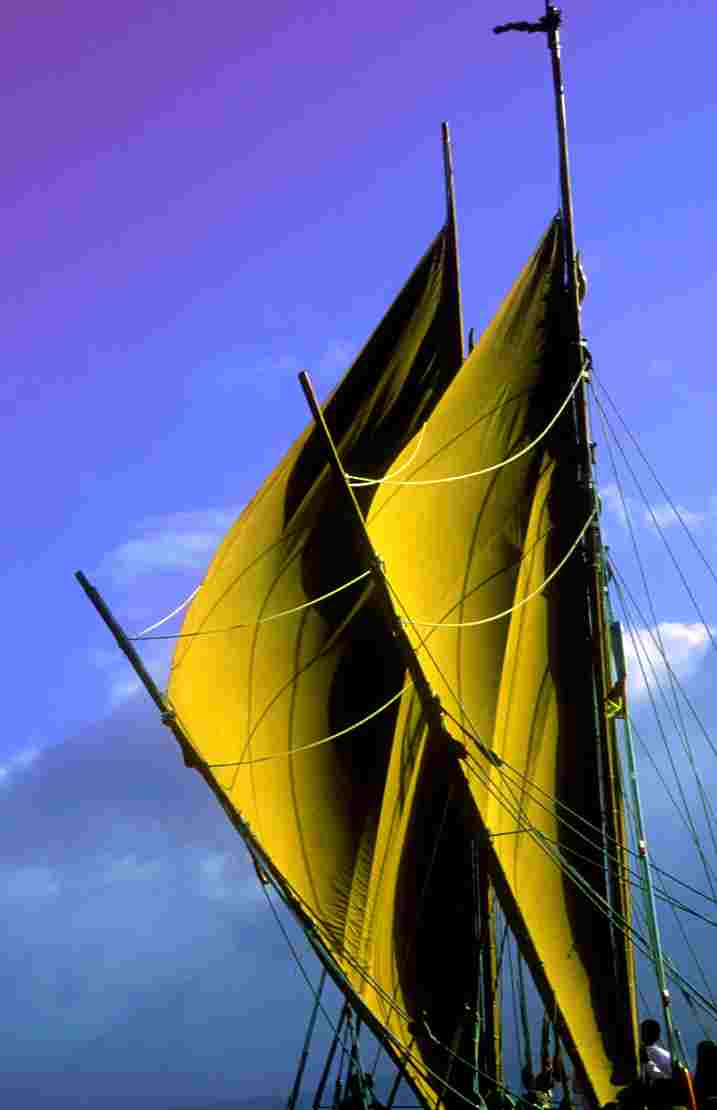 A
Quarter-Century of Achievement A
Quarter-Century of Achievement
By now, it has become abundantly clear that the voyaging process is
much more than a way of finding landfall or sailing a canoe. It is
a method for achieving success that embodies universal human values
- vision, planning, discipline, courage and aloha. What began as a
scientific experiment to build a replica of a traditional canoe for
a one-time sail to Tahiti has become a catalyst for a generation of
cultural renewal.
"When I look at Höküle'a I see a community," says Nainoa. "I see visions
of Eddie Aikau - of sacrifice. I see great joy in children. I see
it pulling a people together. I see sheer beauty in its lines and
images. I see it being a part of this new vision for Hawai'i. I see
the canoe teaching us deep lessons."
Höküle'a, Hawai'iloa, Makali'i and the other canoes throughout Polynesia
have joined men and women of all races and ethnic groups in a common
endeavor to revive a profound and ancient tradition. Over the last
twenty-five years, the family of the voyaging canoe has grown to more
than 525,000 men, women and children who have participated in PVS
programs of education, training, research and dialogue.
And the incredible voyage continues. In 1996, PVS joined with The
Queen's Health Systems in a program to improve Native Hawaiian health.
For ten months, Höküle'a sailed throughout the Islands - a 2,000-mile
journey, during which more than 25,000 schoolchildren and community
members visited or sailed aboard the canoe. "The message of the voyage,"
says PVS President Pinky Thompson, "was that we cannot have a healthy
culture unless we improve the physical health of our people. Taking
responsibility for our own health - and, ultimately, the health of
our planet - is not just a problem for Hawaiians but a problem for
all of us."
The PVS's vision for a healthy Island future has since evolved into
a far-reaching educational program called Mälama Hawai'i, or "Caring
for Hawai'i," which Nainoa himself explains in a heartfelt essay on
Page 41 of this special voyaging edition of Hana Hou! And, as the
new millennium dawns, Höküle'a has only just returned from what many
consider to be her most daring adventure: the epic upwind voyage to
the isolated island of Rapa Nui at the extreme eastern end of the
Polynesian Triangle. A personal account of that voyage begins on Page
34. For those of us whose lives have been touched and transformed
by the majesty of Höküle'a, her ultimate lesson has been this: that
humankind's future survival on planet Earth requires that we all care
for each other and our natural environment. As navigator Chad Baybayan
puts it: "The land and the sea and all life on our planet are interconnected.
So if we take care of even the smallest portion of land, or ocean
or the smallest creature, we take care of ourselves."
Many thanks to Dennis Kawaharada, whose Internet timeline provided
the framework for this article.
~ SHL
|

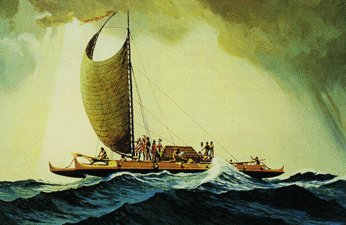







 Soon after the ceremony, six canoes - Höküle'a, Hawai'iloa and Makali'i
from Hawai'i; Te Au o Tonga and Takitumu from Rarotonga; and Te Aurere
from Aotearoa - left the Marquesas Islands for Hawai'i, following
a traditional voyaging route. It was the first time in hundreds of
years that a fleet of Polynesian sailing canoes had journeyed together
- a new 'ohana (family) of the ocean star paths. Almost immediately
after arriving home in Hawai'i, Höküle'a and Hawai'iloa were shipped
to Seattle for a "Voyage of Thanksgiving" along the Pacific coast
of the North American continent. Höküle'a sailed south along the West
Coast, reaching thousands of Hawaiians who no longer lived in the
Islands, but longed to share in the canoe's legacy. Hawai'iloa sailed
north to thank the native peoples of Southeast Alaska for their gift
of trees for her hulls. This was an opportunity for the PVS to give
back to them, but at each stop the canoe and crew were overwhelmed
with gifts and kindness.
Soon after the ceremony, six canoes - Höküle'a, Hawai'iloa and Makali'i
from Hawai'i; Te Au o Tonga and Takitumu from Rarotonga; and Te Aurere
from Aotearoa - left the Marquesas Islands for Hawai'i, following
a traditional voyaging route. It was the first time in hundreds of
years that a fleet of Polynesian sailing canoes had journeyed together
- a new 'ohana (family) of the ocean star paths. Almost immediately
after arriving home in Hawai'i, Höküle'a and Hawai'iloa were shipped
to Seattle for a "Voyage of Thanksgiving" along the Pacific coast
of the North American continent. Höküle'a sailed south along the West
Coast, reaching thousands of Hawaiians who no longer lived in the
Islands, but longed to share in the canoe's legacy. Hawai'iloa sailed
north to thank the native peoples of Southeast Alaska for their gift
of trees for her hulls. This was an opportunity for the PVS to give
back to them, but at each stop the canoe and crew were overwhelmed
with gifts and kindness.  A
Quarter-Century of Achievement
A
Quarter-Century of Achievement